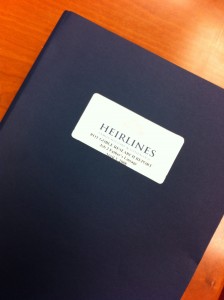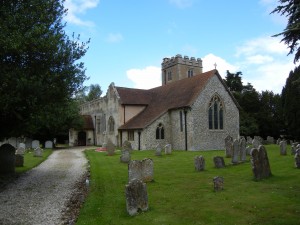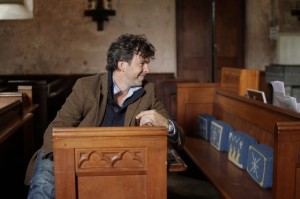I wrote the article below for an upcoming issue of the Goble Family Association newsletter. Yes, there really is such an organization! They were extremely helpful when we did our genealogical research, and they were kind enough to ask that I submit this article. It’s longer than a normal blog post but worth reading all the way to the end.
————–
Every day for twenty-five years I worked side by side with my father (Ernest Goble, 1922-2006) at our family real estate company. It was an honor to spend that time with him, and I am thankful for the many things he taught me about business, life, and family.
Dad battled Parkinsons for over a decade before he finally breathed his last in 2006. It was a great loss for us all, and there was a void in my life. So many questions to ask, so many things to learn, but he was gone. I was grateful that he was in a better place with a renewed spirit and body, but I still felt a profound sense of loss.
Going through his things I found stacks of notes about our family genealogy. I knew he had done some research, traveling back to Oklahoma and Ohio on different occasions. I knew he had also gone to a Goble Family Reunion with his wife Anita. But I had not been particularly interested when he was alive. Going through the notes somehow brought me closer to him.
It struck me that this was a story left unfinished. My Dad never did find out what his true lineage was, so along with my siblings we vowed to find out. Eventually we hired a professional genealogist to help. He helped us sort through the truth from family legend, and we eventually got back to about 1790 or so. But progress was slow and we hit a roadblock after that.
Then I heard about the Goble DNA project. I submitted my markers to see if that would help us break through the logjam. Thankfully, it did. Although we still don’t know exactly where the linkage is, we found out that we are indeed cousins to the many folks who trace their genealogy back to the Puritan and Massachusetts Bay Colonist Thomas Goble.
Earlier this year at a conference in Hawaii I met a fascinating man by the name of Pete Greig. Pete is from Southern England. In a casual way I smiled and said so was I … though removed by some 400-years! He asked where exactly, and I mentioned both Westergate and Aldingbourne. He laughed and said that he drove past Westergate almost everyday to and from work! Impulsively he invited me to visit sometime.
On the flight home from the conference I asked my wife D’Aun about going to Southern England and visiting the old family sites. She had enough of traveling and begged off the trip. Then it struck me that the really wise thing to do was to bring my son Jedd. Not only is he a great traveling companion, but he’s a professional videographer and is almost as interested in history as I am.
So a few months later with cameras packed and high hopes for a grand adventure, we flew to London. Pete met us at the airport and we headed to the little village of Burpham to stay in a B&B that was once owned by Squire Goble in the 1700’s.
Burpham is a mere 10-miles or so from Westergate and Aldingbourne. Westergate is a modern suburb now, complete with strip malls and gas stations. But Aldingbourne retains the feel of an older, slower time. Amidst vast tracks of open space are a few homes, and they surround the thousand-year-old parish St. Mary the Virgin. It was here that Thomas Goble married Alice Brookman in 1619. Fifteen years later they moved to America.
St. Mary the Virgin is a beautiful old church. It has architecture going back to the Normans. Pete showed us where Cromwell’s forces would have ripped out the alter (you can still see the damaged foundation), and we noticed a list of Church Wardens going back to the 1500’s that included “Allan Goble” in 1670.
But what struck me is how little the church had changed in the last 400-years. The same baptismal and Saxon era font are still being used. The same Norman arches exist and the same beautiful Consecration Crosses are painted on the walls. The same carvings on the front door exist, indicating those who had gone to Jerusalem and back. Even the bells in the bell tower are the same, having been placed there just a few years before the Goble-Brookman wedding. It stunned me to think that those bells would have rung on their wedding day.
Coincidentally, a few ladies were in the church decorating for a wedding. They were so kind and truly interested in why we had come to visit. I wondered aloud what the church might have looked like for the wedding 400-years ago, and one kindly older woman said, “Much like it does now that we’ve decorated it. The flowers would have all been the same because they are all local plants, and the layout hasn’t changed.” How perfect was our timing that we could see the church decorated thus?
At one point we had the church all to ourselves (“Lock up when you leave, dears. And enjoy your time!”). I sat there in silence, relishing the moment. Pete suggested we pray and I thought that was a wonderful idea. Now, you must understand that Pete is no ordinary man of prayer; he is the founder of the 24-7 Prayer movement that is sweeping across Europe. So when he prays, you truly sense the presence of the Spirit.
And what a prayer he gave that day. He spoke of the importance of faith handed down generation to generation, of the power of family, of the foundation that Thomas and Alice created for our lives today. His strong voice conveyed the mystery of love between fathers and sons, and the significance of honoring all those who have gone before us.
In the midst of the prayer, I thought of my father. I missed him. He would have been so happy to be here with us. Then I noticed my son, his eyes closed and head bowed, and I thought … Dad is here. He is part of this. His presence felt as real as if he had his arm around me. I smiled as I whispered, “And someday, Dad, we’ll be together again, invisibly sitting beside Jedd and his son, relishing the beauty of family.”
The void that I have felt since Dad’s earthly time came to a close was largely filled that day. I still miss him, of course, but the time in Aldingbourne – a place my Dad had never seen or even heard of – made me realize just how present he really is today. It was a healing trip, a time of renewed understanding, and a moment of quiet reflection in a hectic world. I am thankful for that and eager to return soon.



